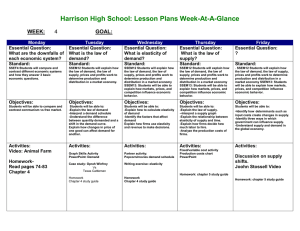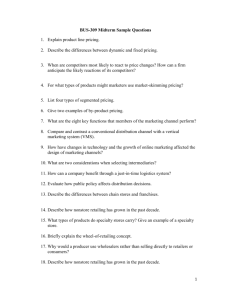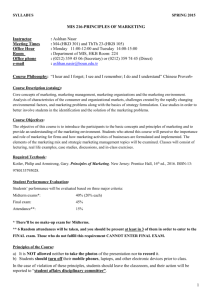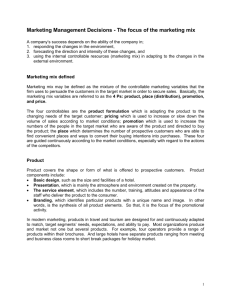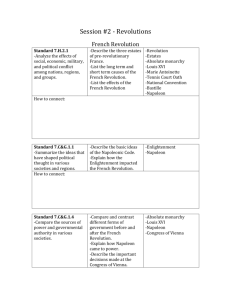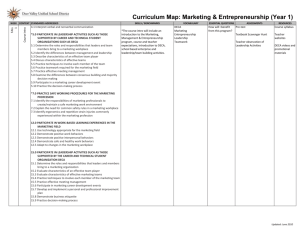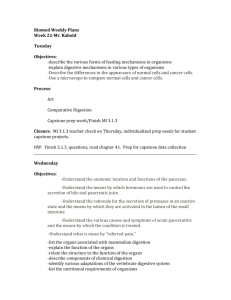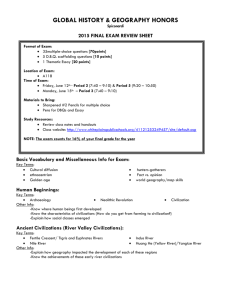Introduction to Marketing (10-12)
advertisement
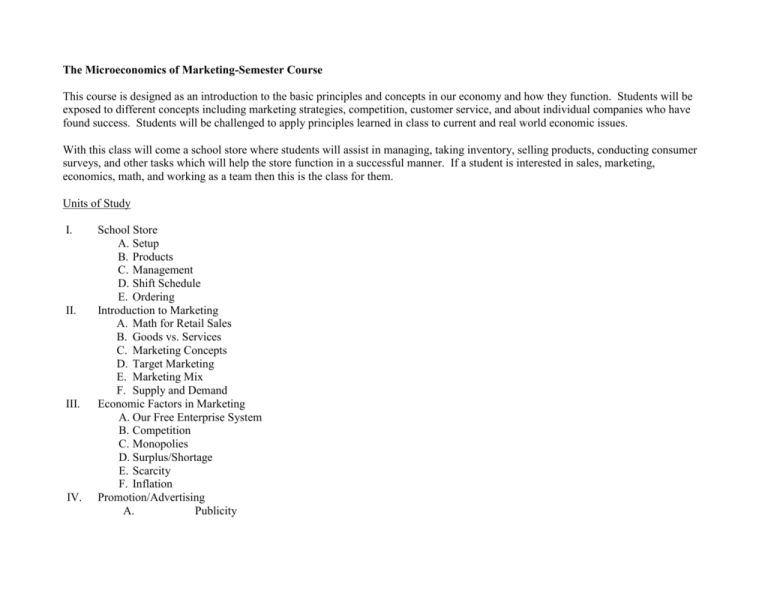
The Microeconomics of Marketing-Semester Course This course is designed as an introduction to the basic principles and concepts in our economy and how they function. Students will be exposed to different concepts including marketing strategies, competition, customer service, and about individual companies who have found success. Students will be challenged to apply principles learned in class to current and real world economic issues. With this class will come a school store where students will assist in managing, taking inventory, selling products, conducting consumer surveys, and other tasks which will help the store function in a successful manner. If a student is interested in sales, marketing, economics, math, and working as a team then this is the class for them. Units of Study I. II. III. IV. School Store A. Setup B. Products C. Management D. Shift Schedule E. Ordering Introduction to Marketing A. Math for Retail Sales B. Goods vs. Services C. Marketing Concepts D. Target Marketing E. Marketing Mix F. Supply and Demand Economic Factors in Marketing A. Our Free Enterprise System B. Competition C. Monopolies D. Surplus/Shortage E. Scarcity F. Inflation Promotion/Advertising A. Publicity B. Licensing C. Promotional Advertising D. Print Media E. Broadcast Media F. Other forms of Media G. Headline H. Slogan V. Buying and Distribution A. Channel of Distribution B. Carriers C. Storage D. Invoice E. Stock VI. Pricing A. Market Share B. Inelastic/Elastic C. Markup D. Discounts VII. Marketing Research A. Database B. Marketing Information System C. Data D. Research Methods VIII. Product Planning A. Product Mix B. Branding C. Labeling D. Location Length of Unit 1 week Unit Title School Store Content Standards Student Outcomes E1.1.2-Entrepreneurship Students will: -learn how to setup, run, and make transactions Essential Questions What is important with running/operating the Blazer Cave? Why are products placed in certain locations? -shift schedule will be discussed and requirements for the class will be known. How does the computer work with checkout? Assessment School Store intro. quiz 2 weeks Intro. To Marketing E1.2.1-Business Structures Students will: -survey different types of marketing standards used. -demonstrate problem-solving and decision-making skills as they apply in human relations, market information management, or product service planning. Length of Unit Unit Title Content Standards Student Outcomes What is the most crucial part of Marketing basics the marketing mix when test relating to target markets? When analyzing logos and trademarks, which is the most recognizable to the target market? Essential Questions Assessment 3 weeks Economic factors in Marketing E1.3.1-Law of Supply Students will: E1.3.2-Law of Demand -understand the role and characteristics of marketing three different types of economic systems: capitalism, socialism, and communism. E1.3.3-Price, Equilibrium, Elasticity, and Incentives E.1.2.2-Price in the Market 3 weeks Promotion/ E3.2.5-The Global Advertising Economy and the Marketplace -demonstrate decision-making skills as they apply in human relations, market information management, and product planning. Students will: -Explain the types of promotional How does the economic system Economic of a country affect the way Factors Unit companies market their Test products? What roles does supply and demand play in the way marketing occurs? How are company revenues and profits influenced by the economic system of a country What role does advertising play Promote a in the American free commerce Product Project system? E3.2.1-Absolute and What parts of the promotional Comparative Advantage -Explain the role of promotion mix are the most important as a marketing function. when reaching out to the target market? -Identify the elements of the promotional mix What appeals to the consumer when it comes to advertising -Explain the types of and promotion? advertising media and components of advertising Length of Unit Unit Title Content Standards Student Outcomes Essential Questions Assessment 2 weeks Students will: Buying and E1.3.3-Price, Distribution Equilibrium, Elasticity, and Incentives -Understand business, management, and entrepreneurial concepts that affect business decision making -Explain the shipping and receiving process What does the buying and distribution cycle have to do with the pricing that is passed on to the consumer? Buying and Distribution Unit Test How does the price that goods are purchased for affect how the marketing mix and programs are established for good? -Explain channels of distribution and the nature and scope of distribution -Describe the relationship between customer service and distribution 3 weeks Pricing E1.3.3-Price, Students will: Equilibrium, Elasticity, and Incentives -Understand concepts and strategies utilized in E.1.2.2-Price in the determining and adjusting Market prices to maximize return and meet customers' perceptions of value What is the effect pricing has on our beliefs about products and services? Pricing Unit Test With all other things remaining constant, is price the most important part of selecting a product or service to purchase? -Explain factors affecting pricing decisions Length of Unit Unit Title Content Standards Student Outcomes Essential Questions Assessment 2 weeks Marketing Research E1.3.1-Law of Supply Students will: E.1.3.2-Law of Demand -Understand the concepts and actions needed to determine client needs and wants and respond through planned, personalized communication that influences purchase decisions What importance does Complete their marketing research play in the own marketing overall marketing strategy of a research project new product? If marketing strategy were done away with altogether, would the products and services we have be as tailored to our needs as they are currently? -Acquire product information for use in selling -Analyze product information to identify product features and benefits 2 weeks Product Planning E1.1.1-Scarcity, Choice, Students will: Opportunity Costs, and Comparative Advantage -Acquire product information for use in selling When deciding what items to include in a product line, how much does marketing research play into the overall plan? -Analyze product information Does product research play the to identify product features and most important role in benefits developing a product plan? -Determine customer/client needs -Identify customer buying motives for use in selling Does the product line a company produces really sell the product or do we, as a society, need the constant advertisements and reminders of the products? What makes a product Product Planning Project recognizable?

